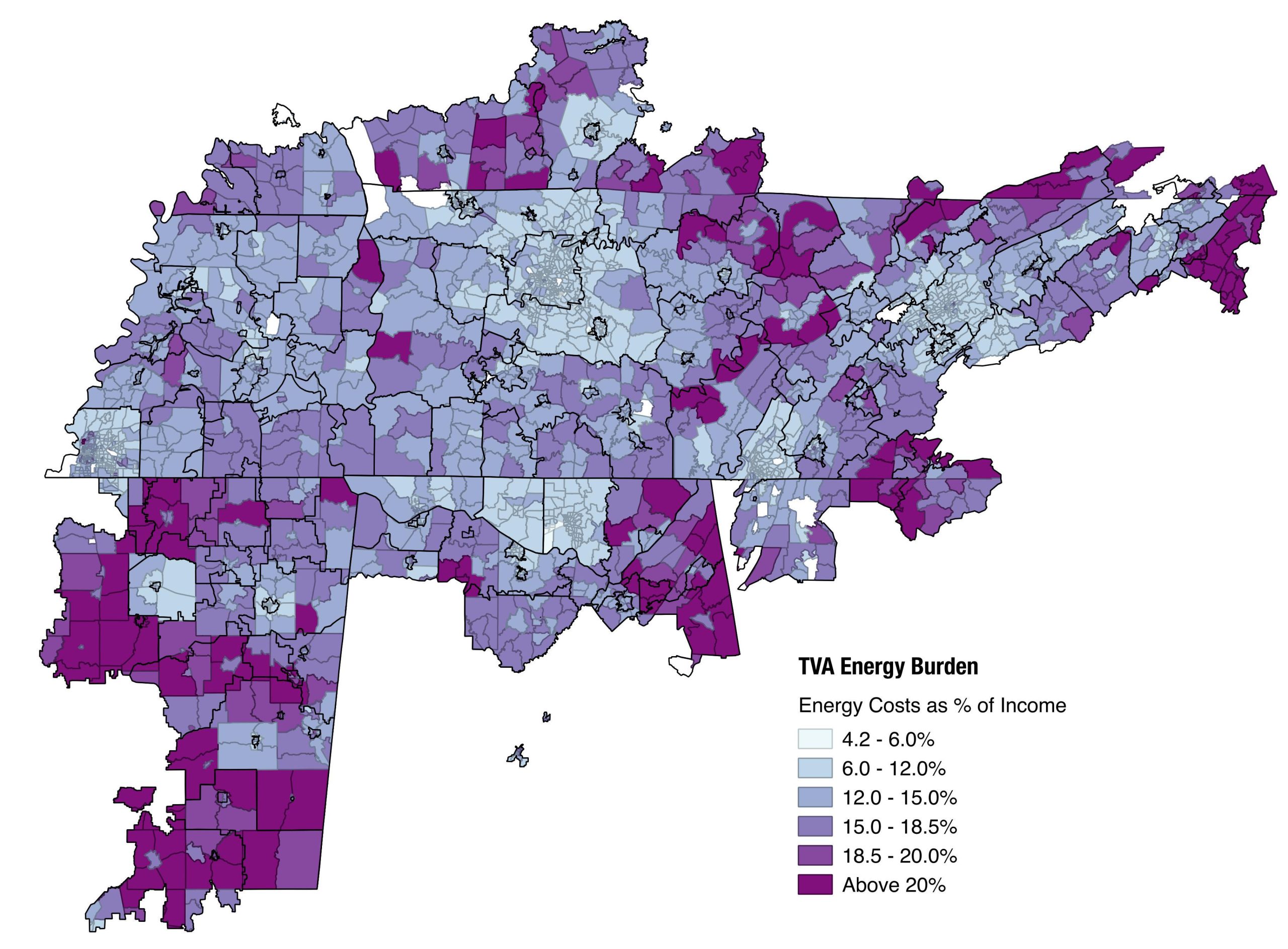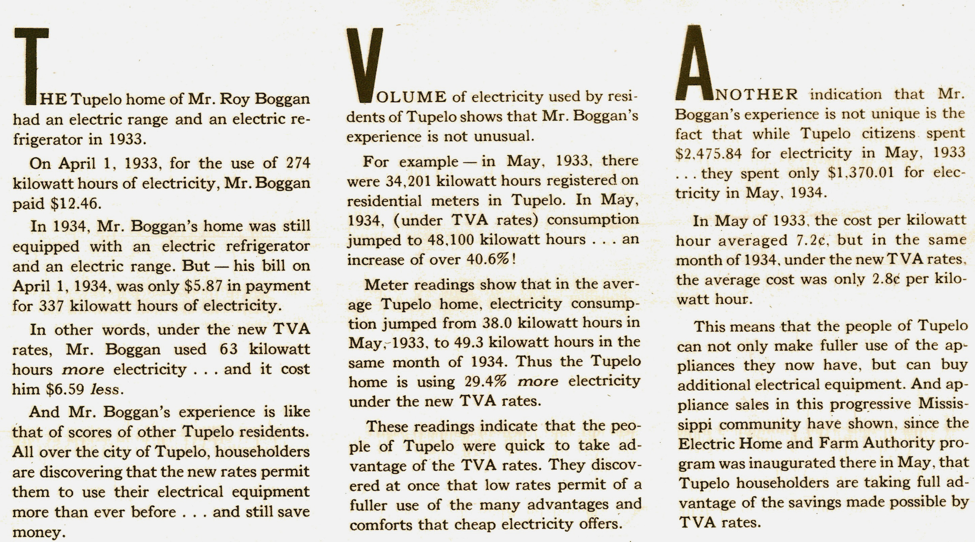SACE has already revealed how TVA’s existing mandatory fees favor industrial customers at the expense of residents. Now, a new policy change could make this problem even worse. TVA is proposing a grid access charge that would disproportionately harm low-income households. Adding this charge to the rate structure could worsen income inequality in the Valley by making energy costs a truly unaffordable economic burden. The typical threshold for energy costs to be considered unaffordable is above 6% of household income spent on energy. So just how high is this number for TVA’s low-income customers?

TVA Customers at Low Income Levels have High Energy Burdens, Especially in Rural Areas
On average, low-income households in TVA’s service territory spend 12.6 % of their annual household income on energy costs. We calculated the average energy burden, defined as a percentage of household income spent on energy, by census tract (left) for all households meeting federal low-income guidelines. Overall, the findings are consistent with expert analysis such as ACEEE’s report that shows how customers in the Southeast tend to have much higher energy burdens than other regions. The average low-income TVA customer pays more than double the level that is considered unaffordable (the same data & map displayed as unaffordable vs. affordable looks something like this) and nearly four times the national average.
The highest burdens occur in municipal utilities in rural areas. This is unsurprising given TVA’s history. The original justification for creating TVA was rooted in a stark disparity in terms of access to electricity: in the most rural parts of the Valley, customers had little or no access to electricity while other parts of the country had been electrified for years. Unfortunately, our findings indicate that this disparity is still alive in many ways today. In general, rural customers are more likely to make sacrifices in comfort and health in order to maintain a below average energy bill.
The average burden can range from 7.1% to 28.7% depending on the local power company (LPC). When census tracts are allocated to service territories and aggregated by LPC, we see that the highest energy burdens are found in rural municipalities, and lower burdens are found in larger LPCs like Murfreesboro Electric Department or Electric Power Board of Chattanooga. (A full list is available in Appendix B of SACE’s comment letter) The distinction between local power companies and TVA is a significant one. TVA is the entity that proposes and sets rate structures (and serves industrial customers), but LPCs are the ones that must implement the changes since they deliver the actual energy to residential customers. And since they are also the ones to send the bills to customers, the local power company is typically the first to hear if a customer is upset (usually justifiably) with high costs.
For TVA’s Low-Income Customers, Costs are Unaffordable Despite Using Less Energy

The fact that low-income households have high energy burdens is to be expected. After all, at low incomes, even an average energy bill can result in a high energy burden. But the part where this becomes problematic is reflected in TVA CEO Bill Johnson’s line of thinking in regards to the proposed grid access charges: “high energy burden people will pay lower bills. Because we’re going to reduce the energy cost the amount we put on the fixed cost. If you’re a high energy user, if you live in an inefficient house, you’re going to save money in this rate design.” Bill Johnson incorrectly assumes that high energy burdens are the result of high energy usage – in reality, households experiencing high energy burdens actually use less energy than others.
The estimated electricity usage by income level (above left) indicates that there is no relationship between high energy burdens and high energy usage. Taking into account the factors related to energy costs within the TVA system ($/kwh prices and mandatory fees in the current rate structure), we are able to see that households at any low income level use less energy than those with high incomes. On average, lower income levels use 7.5% less electricity, and at the highest disparity (30-50% AMI vs. over 100%), they use approximately 24.7% less.
TVA’s Grid Access Charge Will Disproportionately Harm Low-Income Households
The retail rate structures that TVA’s proposed Grid Access Charge (GAC) would promote are intended to encourage load growth, which will primarily benefit customers with higher energy use. Because high-income households are likely to use more, TVA’s low-income residential customers will be negatively and disproportionately impacted. Depending on the retail rate structure and ultimate level of the GAC, these customers will see their “energy burden” increase by between 0.1% and 1.9% systemwide. For low-income customers of some of LPCs, the average impact could be as much as 2.8% of their household income. (If TVA’s CEO Bill Johnson had to endure an impact equal to that customer group, it would translate to a $182,000 loss of income down the drain – he would lose more than most of these households earn in several years!) The impacts on low-income customers across the entire system would also add up very quickly: over 40 percent of the households in TVA’s service territory fall within federal low income limits.
Each of the different proposed rate structures would have the effect of decreasing a customer’s incentive to reduce their energy usage. This is made all the more troubling given that customers at these low income levels are already unlikely to have access to the same methods of bill control as their higher income counterparts. Some TVA LPCs have taken steps to develop customer-oriented opportunities to gain greater control over their bills through clean methods of bill control such as energy efficiency or distributed generation like solar PV. Often, these programs are the only opportunity this customer group has to reduce energy costs and the corresponding energy burden. Overall, a grid access charge only has the effect of being discriminatory against lower income customer groups.
TVA is Ignoring Its Own History of Helping Make Energy Costs Affordable
 The existence of a connection between income inequality and the proposed grid access charge is a signal that TVA has abandoned its original purpose. When the Tennessee Valley Authority Act was signed in 1933, it defined the need to “permit domestic and rural use at the lowest possible rates and in such a manner to encourage increased domestic and rural use of electricity.” Indeed, as early as 1934, TVA had begun touting the ability of its rate to make costs more affordable (right) for customers. Now, this responsibility is left primarily to local power companies while TVA fails to take significant action on behalf of residential customers.
The existence of a connection between income inequality and the proposed grid access charge is a signal that TVA has abandoned its original purpose. When the Tennessee Valley Authority Act was signed in 1933, it defined the need to “permit domestic and rural use at the lowest possible rates and in such a manner to encourage increased domestic and rural use of electricity.” Indeed, as early as 1934, TVA had begun touting the ability of its rate to make costs more affordable (right) for customers. Now, this responsibility is left primarily to local power companies while TVA fails to take significant action on behalf of residential customers.
The mandate also allowed the “sale to and use by industry” of electricity generated by TVA, but did specify that it “shall be a secondary purpose”. In present day, TVA continues to favor these industrial customers over everyday households again and again. It seems that TVA’s interest in fair rate design is outweighed by its desire to protect and increase its revenue – all at the expense of vulnerable, low-income customers.
Want to know how this will affect your local power company’s rates? Here are some tables that spell out the specifics:
- Analysis of mandatory fees by local power company (LPC), and the potential impact of TVA’s grid access charge (GAC) on those fees
- Analysis of TVA’s grid access charge and industrial rate shift on lower-income customers, by LPC
- Analysis of TVA’s industrial rate shift impacts on residential rates, by LPC


